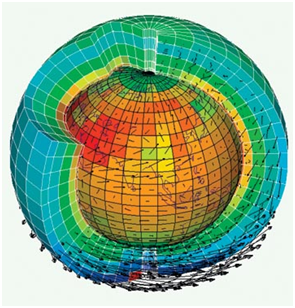Atmospheric Transport Model LMDz

When assimilating atmospheric concentration measurements (e.g. CO2), the transport model becomes an essential component of the Data Assimilation System that relates the surface fluxes to the atmospheric concentration data. It follows the configuration of the General Circulation Model LMDz model (Hourdin et al., 2006) as implemented in the coupled climate simulations for the IPCC AR4 report (IPCC, 2007). The dynamical part of the GCM is based on a finite-difference formulation of the primitive equations solved on a 3D Eulerian grid with a typical horizontal resolution of 3.75° (longitudes) x 2.5° (latitudes) and 19 sigma-pressure layers up to 3hPa. This corresponds to a vertical resolution of about 300-500 m in the planetary boundary layer (first level at 70 m height) and to a resolution of about 2 km at the tropopause (with 7-9 levels located in the stratosphere). The calculated winds (u and v) are relaxed to ECMWF analyzed meteorology with a relaxation time of 2.5h (nudging) in order to realistically account for large scale advection (Hourdin et al., 2000). The advection of tracers is calculated based on the finite-volume, second-order scheme as described by Hourdin and Armengaud (1999). Deep convection is parameterized according to the scheme of Tiedtke (1989) and the turbulent mixing in the planetary boundary layer is based on a local second-order closure formalism.







